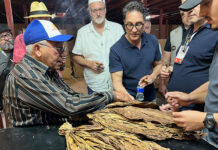“One day I won salesman of the year, and I got a bonus check and a pink slip at the same time,” he says. “I said to myself, ‘You know, I don’t understand this because there’s no such thing as an overpaid salesman when you’re on commission.’ My son was going to college at the time, and I said, ‘Look, I can’t continue doing this. I can’t keep building these companies, and I’ve got nothing to show for it.’ So I called them up and I told them, ‘Listen, this might be the smartest thing I’ve ever done or the dumbest thing, but I want to start my own company. I have a lot of connections, you know, and let’s go to work.’”
Making the transition from sales representative to brand owner was tough, Espinosa explains. His years of experience had taught him there was a lot more to the success formula than what most people think, and it’s a discussion he has today with many people who ask him about getting into the cigar business. There has to be a business plan in place from the start, he explains, and it has to include who the cigars will be sold to. This, again, sounds a lot easier than it is in reality.
“It doesn’t matter how good the cigar is,” he states boldly. “First of all, there are a lot of great cigars out there, and it takes a lot of money. So yes, you’re going to sell it to the store you hang out in, [and] they’re going to buy it because they know you, and then you might know another store. After that, what are you going to do? Do you have salespeople in the street? OK, are you going to sell it online? OK, if you sell it online and you open up a website, then that’s a great game plan because you’re getting paid right away. OK, now it’s your job to promote it and all that. I think that’s the route to go, but to get in this game right now, it’s very, very, very hard.”
Another reality is that there are tons of cigars and brands to choose from today, yet retailers only have so much space to work with. This makes being in the cigar business very difficult, but Espinosa has learned how to manage the bumps in the road in order to set his company and its products up for success. One key to his success is understanding how much work is required to maintain what’s been created and how easy it is to lose everything.
“No matter how hard you work—like we’re on top now, and we’re doing very, very well—but you can do one wrong thing, and it all comes tumbling down. You have to maintain, and you have to keep knocking on doors, and you’ve gotta keep promoting. One thing is the quality of what we make … it’s got to be one of the best in the industry because we don’t cut corners. If the cigar’s not good, I don’t sell it.”
Part of making good cigars is knowing what the market wants from a cigar. When creating a new cigar, the Espinosa Cigars team first begins with the wrapper. This, Espinosa explains, is the easiest part of the process. When they know what wrapper they’re working with, the real work begins. How are they going to make this cigar different from the others in the company’s portfolio?
“I don’t want two cigars that taste the same,” Espinosa states firmly.
Figuring out who they are targeting with the cigar is an important step in the blending process. Espinosa doesn’t make many mild cigars because through social media he noticed that most of his company’s followers were discussing and posting about medium to full-bodied cigars. Another realization he had from social media is that his company’s followers aren’t the type to buy a cigar solely based on it being a name brand; instead, their customers typically look for flavor and variety, something they often find in a boutique cigar. Once they know the wrapper, the strength and the customer they’re targeting, the Espinosa Cigars team will make a lot of blends that will then be set aside for a certain period of time before being shipped to the U.S. Why? Because another thing Espinosa and his team have learned over the years is that a cigar tastes different in Nicaragua, where the company’s La Zona factory is located, than it does in the U.S. While he doesn’t have control over when and how a consumer chooses to light up an Espinosa cigar, he does make sure only the highest quality products make it onto store shelves.
This story first appeared in the November/December 2022 issue of Tobacco Business magazine. You can view the entire issue online for free by clicking here.
– Photography by Slav Gordeyev. Story by Antoine Reid, senior editor and digital director for Tobacco Business Magazine. You can follow him on Instagram @editor.reid.







